An Analysis of Apple's International Business Operations and Strategy
VerifiedAdded on 2022/09/11
|13
|3452
|22
Essay
AI Summary
This essay provides a comprehensive analysis of Apple Inc.'s international business operations, focusing on its background, competitiveness, and strategy within the context of England. The essay begins with a brief profile of Apple, outlining its history, core products, and global presence as a multinational enterprise (MNE). It then delves into Apple's core resources and capabilities, including its financial strength, technological innovation, leadership, and business processes, highlighting how these factors contribute to its competitive advantage. The second part of the essay examines the host country environment, specifically England, assessing the political, economic, social, and technological factors that influence Apple's operations. The analysis considers the impact of political stability, taxation, and Brexit on Apple's business. Finally, the essay explores Apple's international strategy in England, emphasizing its use of standardization as an international strategy. It discusses the benefits and challenges of this approach, including market penetration, cost management, and the adaptation to local market conditions.
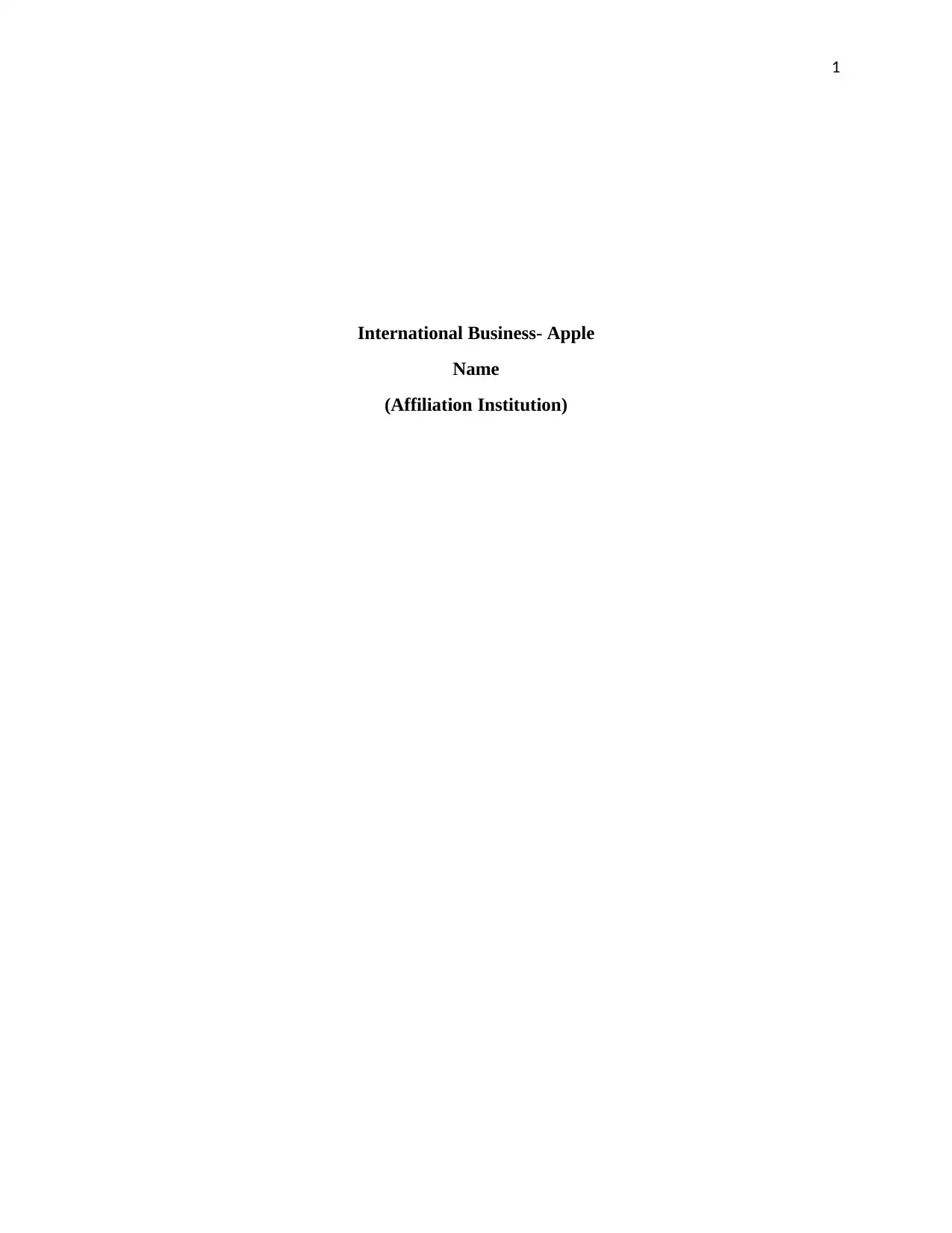
1
International Business- Apple
Name
(Affiliation Institution)
International Business- Apple
Name
(Affiliation Institution)
Paraphrase This Document
Need a fresh take? Get an instant paraphrase of this document with our AI Paraphraser
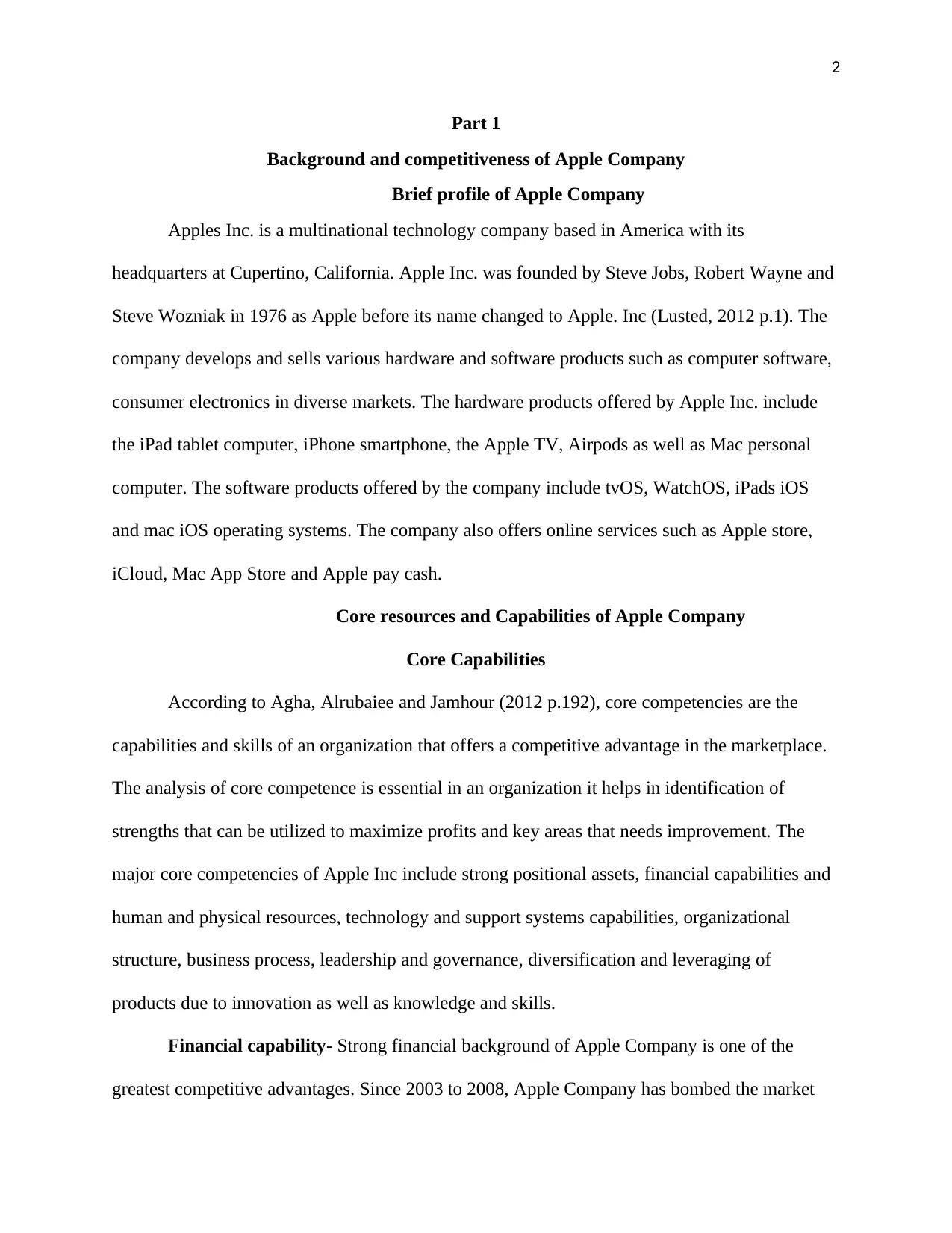
2
Part 1
Background and competitiveness of Apple Company
Brief profile of Apple Company
Apples Inc. is a multinational technology company based in America with its
headquarters at Cupertino, California. Apple Inc. was founded by Steve Jobs, Robert Wayne and
Steve Wozniak in 1976 as Apple before its name changed to Apple. Inc (Lusted, 2012 p.1). The
company develops and sells various hardware and software products such as computer software,
consumer electronics in diverse markets. The hardware products offered by Apple Inc. include
the iPad tablet computer, iPhone smartphone, the Apple TV, Airpods as well as Mac personal
computer. The software products offered by the company include tvOS, WatchOS, iPads iOS
and mac iOS operating systems. The company also offers online services such as Apple store,
iCloud, Mac App Store and Apple pay cash.
Core resources and Capabilities of Apple Company
Core Capabilities
According to Agha, Alrubaiee and Jamhour (2012 p.192), core competencies are the
capabilities and skills of an organization that offers a competitive advantage in the marketplace.
The analysis of core competence is essential in an organization it helps in identification of
strengths that can be utilized to maximize profits and key areas that needs improvement. The
major core competencies of Apple Inc include strong positional assets, financial capabilities and
human and physical resources, technology and support systems capabilities, organizational
structure, business process, leadership and governance, diversification and leveraging of
products due to innovation as well as knowledge and skills.
Financial capability- Strong financial background of Apple Company is one of the
greatest competitive advantages. Since 2003 to 2008, Apple Company has bombed the market
Part 1
Background and competitiveness of Apple Company
Brief profile of Apple Company
Apples Inc. is a multinational technology company based in America with its
headquarters at Cupertino, California. Apple Inc. was founded by Steve Jobs, Robert Wayne and
Steve Wozniak in 1976 as Apple before its name changed to Apple. Inc (Lusted, 2012 p.1). The
company develops and sells various hardware and software products such as computer software,
consumer electronics in diverse markets. The hardware products offered by Apple Inc. include
the iPad tablet computer, iPhone smartphone, the Apple TV, Airpods as well as Mac personal
computer. The software products offered by the company include tvOS, WatchOS, iPads iOS
and mac iOS operating systems. The company also offers online services such as Apple store,
iCloud, Mac App Store and Apple pay cash.
Core resources and Capabilities of Apple Company
Core Capabilities
According to Agha, Alrubaiee and Jamhour (2012 p.192), core competencies are the
capabilities and skills of an organization that offers a competitive advantage in the marketplace.
The analysis of core competence is essential in an organization it helps in identification of
strengths that can be utilized to maximize profits and key areas that needs improvement. The
major core competencies of Apple Inc include strong positional assets, financial capabilities and
human and physical resources, technology and support systems capabilities, organizational
structure, business process, leadership and governance, diversification and leveraging of
products due to innovation as well as knowledge and skills.
Financial capability- Strong financial background of Apple Company is one of the
greatest competitive advantages. Since 2003 to 2008, Apple Company has bombed the market
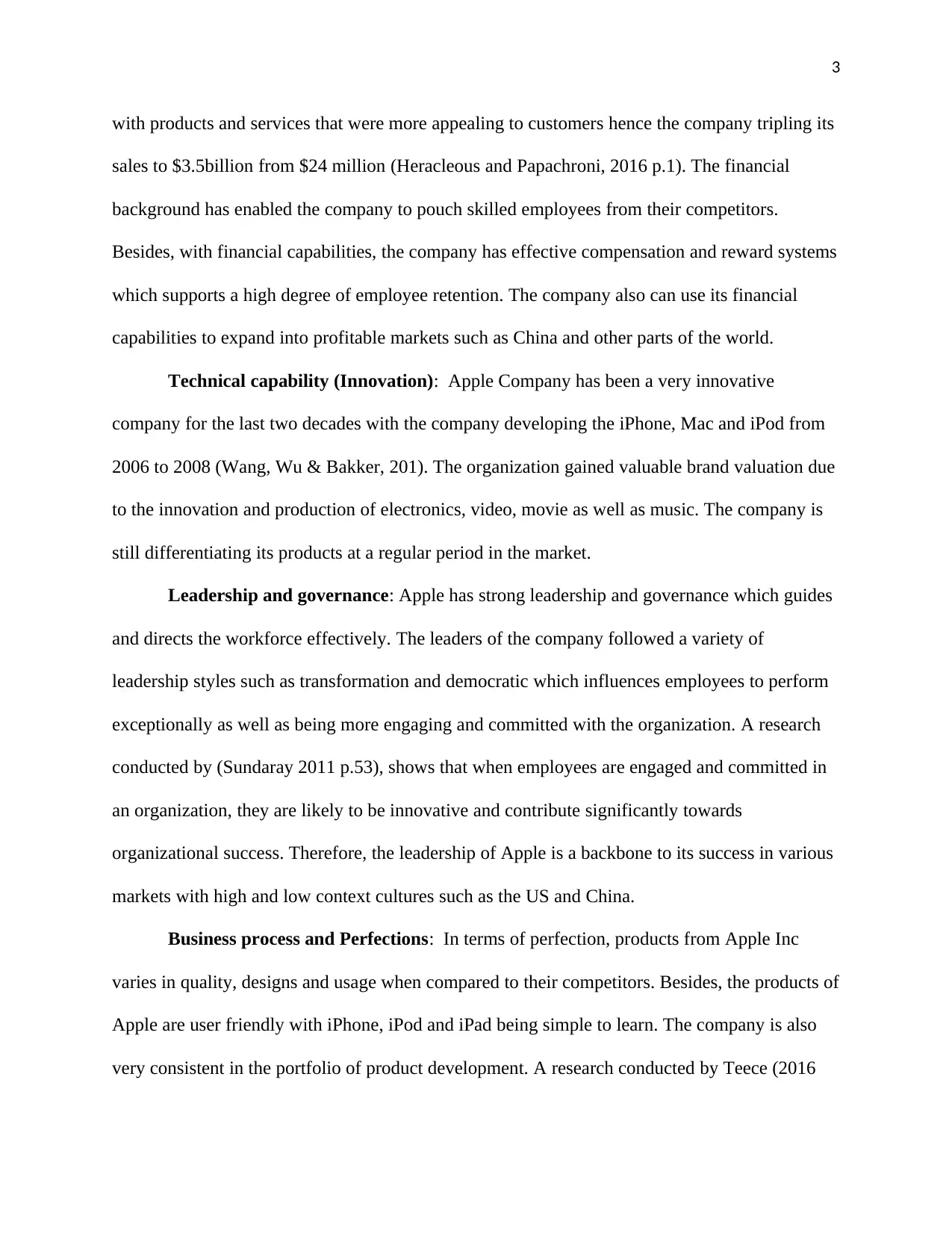
3
with products and services that were more appealing to customers hence the company tripling its
sales to $3.5billion from $24 million (Heracleous and Papachroni, 2016 p.1). The financial
background has enabled the company to pouch skilled employees from their competitors.
Besides, with financial capabilities, the company has effective compensation and reward systems
which supports a high degree of employee retention. The company also can use its financial
capabilities to expand into profitable markets such as China and other parts of the world.
Technical capability (Innovation): Apple Company has been a very innovative
company for the last two decades with the company developing the iPhone, Mac and iPod from
2006 to 2008 (Wang, Wu & Bakker, 201). The organization gained valuable brand valuation due
to the innovation and production of electronics, video, movie as well as music. The company is
still differentiating its products at a regular period in the market.
Leadership and governance: Apple has strong leadership and governance which guides
and directs the workforce effectively. The leaders of the company followed a variety of
leadership styles such as transformation and democratic which influences employees to perform
exceptionally as well as being more engaging and committed with the organization. A research
conducted by (Sundaray 2011 p.53), shows that when employees are engaged and committed in
an organization, they are likely to be innovative and contribute significantly towards
organizational success. Therefore, the leadership of Apple is a backbone to its success in various
markets with high and low context cultures such as the US and China.
Business process and Perfections: In terms of perfection, products from Apple Inc
varies in quality, designs and usage when compared to their competitors. Besides, the products of
Apple are user friendly with iPhone, iPod and iPad being simple to learn. The company is also
very consistent in the portfolio of product development. A research conducted by Teece (2016
with products and services that were more appealing to customers hence the company tripling its
sales to $3.5billion from $24 million (Heracleous and Papachroni, 2016 p.1). The financial
background has enabled the company to pouch skilled employees from their competitors.
Besides, with financial capabilities, the company has effective compensation and reward systems
which supports a high degree of employee retention. The company also can use its financial
capabilities to expand into profitable markets such as China and other parts of the world.
Technical capability (Innovation): Apple Company has been a very innovative
company for the last two decades with the company developing the iPhone, Mac and iPod from
2006 to 2008 (Wang, Wu & Bakker, 201). The organization gained valuable brand valuation due
to the innovation and production of electronics, video, movie as well as music. The company is
still differentiating its products at a regular period in the market.
Leadership and governance: Apple has strong leadership and governance which guides
and directs the workforce effectively. The leaders of the company followed a variety of
leadership styles such as transformation and democratic which influences employees to perform
exceptionally as well as being more engaging and committed with the organization. A research
conducted by (Sundaray 2011 p.53), shows that when employees are engaged and committed in
an organization, they are likely to be innovative and contribute significantly towards
organizational success. Therefore, the leadership of Apple is a backbone to its success in various
markets with high and low context cultures such as the US and China.
Business process and Perfections: In terms of perfection, products from Apple Inc
varies in quality, designs and usage when compared to their competitors. Besides, the products of
Apple are user friendly with iPhone, iPod and iPad being simple to learn. The company is also
very consistent in the portfolio of product development. A research conducted by Teece (2016
⊘ This is a preview!⊘
Do you want full access?
Subscribe today to unlock all pages.

Trusted by 1+ million students worldwide
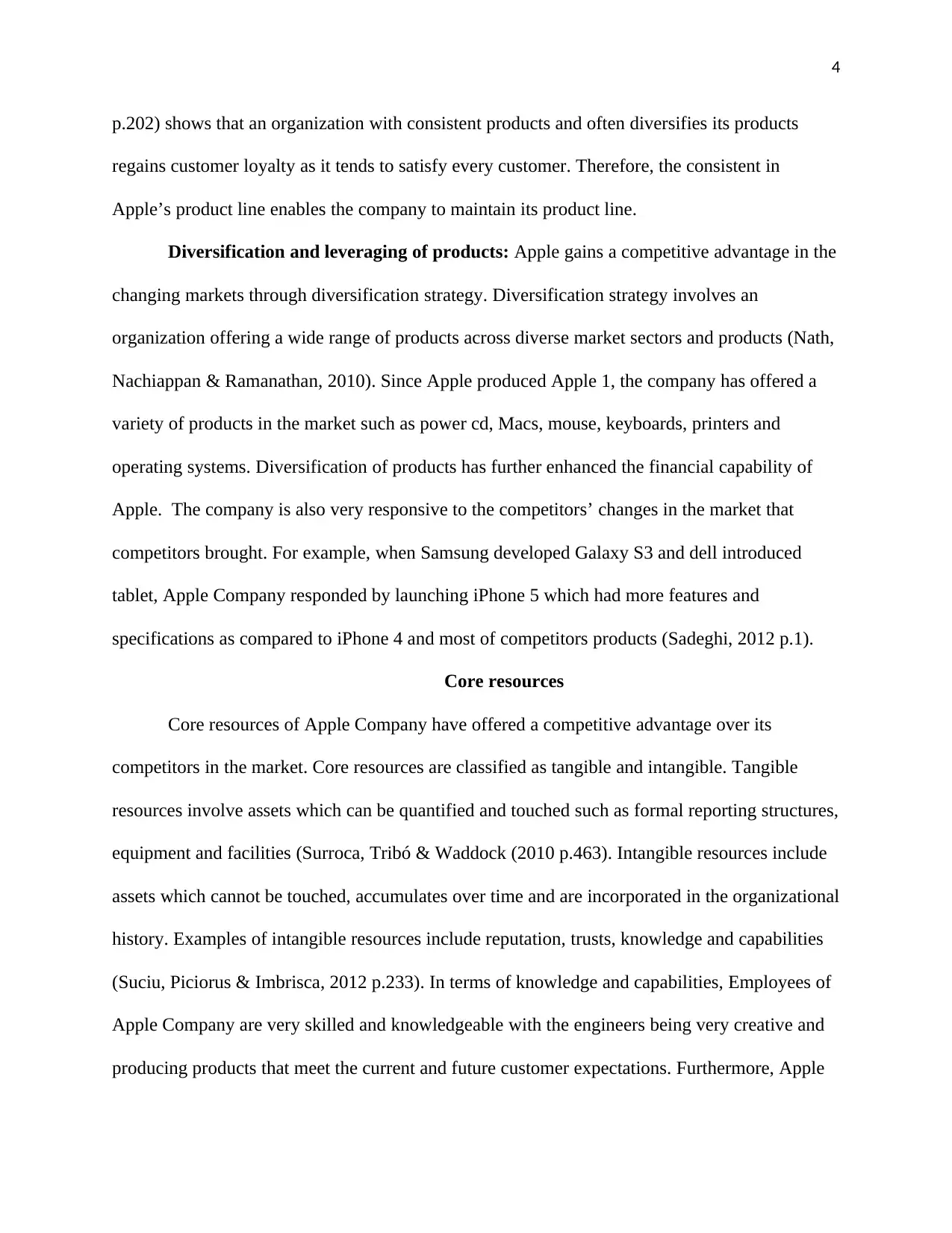
4
p.202) shows that an organization with consistent products and often diversifies its products
regains customer loyalty as it tends to satisfy every customer. Therefore, the consistent in
Apple’s product line enables the company to maintain its product line.
Diversification and leveraging of products: Apple gains a competitive advantage in the
changing markets through diversification strategy. Diversification strategy involves an
organization offering a wide range of products across diverse market sectors and products (Nath,
Nachiappan & Ramanathan, 2010). Since Apple produced Apple 1, the company has offered a
variety of products in the market such as power cd, Macs, mouse, keyboards, printers and
operating systems. Diversification of products has further enhanced the financial capability of
Apple. The company is also very responsive to the competitors’ changes in the market that
competitors brought. For example, when Samsung developed Galaxy S3 and dell introduced
tablet, Apple Company responded by launching iPhone 5 which had more features and
specifications as compared to iPhone 4 and most of competitors products (Sadeghi, 2012 p.1).
Core resources
Core resources of Apple Company have offered a competitive advantage over its
competitors in the market. Core resources are classified as tangible and intangible. Tangible
resources involve assets which can be quantified and touched such as formal reporting structures,
equipment and facilities (Surroca, Tribó & Waddock (2010 p.463). Intangible resources include
assets which cannot be touched, accumulates over time and are incorporated in the organizational
history. Examples of intangible resources include reputation, trusts, knowledge and capabilities
(Suciu, Piciorus & Imbrisca, 2012 p.233). In terms of knowledge and capabilities, Employees of
Apple Company are very skilled and knowledgeable with the engineers being very creative and
producing products that meet the current and future customer expectations. Furthermore, Apple
p.202) shows that an organization with consistent products and often diversifies its products
regains customer loyalty as it tends to satisfy every customer. Therefore, the consistent in
Apple’s product line enables the company to maintain its product line.
Diversification and leveraging of products: Apple gains a competitive advantage in the
changing markets through diversification strategy. Diversification strategy involves an
organization offering a wide range of products across diverse market sectors and products (Nath,
Nachiappan & Ramanathan, 2010). Since Apple produced Apple 1, the company has offered a
variety of products in the market such as power cd, Macs, mouse, keyboards, printers and
operating systems. Diversification of products has further enhanced the financial capability of
Apple. The company is also very responsive to the competitors’ changes in the market that
competitors brought. For example, when Samsung developed Galaxy S3 and dell introduced
tablet, Apple Company responded by launching iPhone 5 which had more features and
specifications as compared to iPhone 4 and most of competitors products (Sadeghi, 2012 p.1).
Core resources
Core resources of Apple Company have offered a competitive advantage over its
competitors in the market. Core resources are classified as tangible and intangible. Tangible
resources involve assets which can be quantified and touched such as formal reporting structures,
equipment and facilities (Surroca, Tribó & Waddock (2010 p.463). Intangible resources include
assets which cannot be touched, accumulates over time and are incorporated in the organizational
history. Examples of intangible resources include reputation, trusts, knowledge and capabilities
(Suciu, Piciorus & Imbrisca, 2012 p.233). In terms of knowledge and capabilities, Employees of
Apple Company are very skilled and knowledgeable with the engineers being very creative and
producing products that meet the current and future customer expectations. Furthermore, Apple
Paraphrase This Document
Need a fresh take? Get an instant paraphrase of this document with our AI Paraphraser
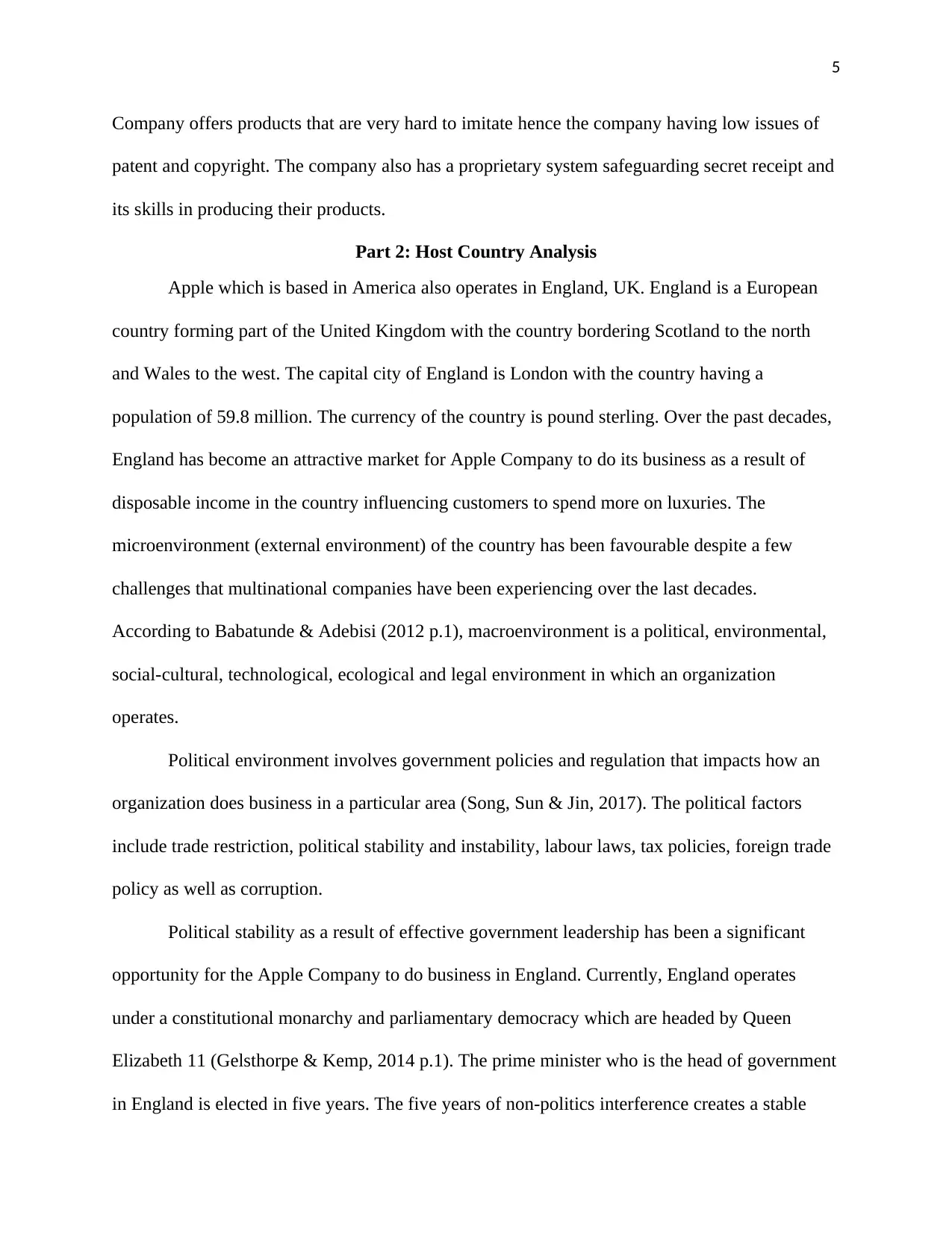
5
Company offers products that are very hard to imitate hence the company having low issues of
patent and copyright. The company also has a proprietary system safeguarding secret receipt and
its skills in producing their products.
Part 2: Host Country Analysis
Apple which is based in America also operates in England, UK. England is a European
country forming part of the United Kingdom with the country bordering Scotland to the north
and Wales to the west. The capital city of England is London with the country having a
population of 59.8 million. The currency of the country is pound sterling. Over the past decades,
England has become an attractive market for Apple Company to do its business as a result of
disposable income in the country influencing customers to spend more on luxuries. The
microenvironment (external environment) of the country has been favourable despite a few
challenges that multinational companies have been experiencing over the last decades.
According to Babatunde & Adebisi (2012 p.1), macroenvironment is a political, environmental,
social-cultural, technological, ecological and legal environment in which an organization
operates.
Political environment involves government policies and regulation that impacts how an
organization does business in a particular area (Song, Sun & Jin, 2017). The political factors
include trade restriction, political stability and instability, labour laws, tax policies, foreign trade
policy as well as corruption.
Political stability as a result of effective government leadership has been a significant
opportunity for the Apple Company to do business in England. Currently, England operates
under a constitutional monarchy and parliamentary democracy which are headed by Queen
Elizabeth 11 (Gelsthorpe & Kemp, 2014 p.1). The prime minister who is the head of government
in England is elected in five years. The five years of non-politics interference creates a stable
Company offers products that are very hard to imitate hence the company having low issues of
patent and copyright. The company also has a proprietary system safeguarding secret receipt and
its skills in producing their products.
Part 2: Host Country Analysis
Apple which is based in America also operates in England, UK. England is a European
country forming part of the United Kingdom with the country bordering Scotland to the north
and Wales to the west. The capital city of England is London with the country having a
population of 59.8 million. The currency of the country is pound sterling. Over the past decades,
England has become an attractive market for Apple Company to do its business as a result of
disposable income in the country influencing customers to spend more on luxuries. The
microenvironment (external environment) of the country has been favourable despite a few
challenges that multinational companies have been experiencing over the last decades.
According to Babatunde & Adebisi (2012 p.1), macroenvironment is a political, environmental,
social-cultural, technological, ecological and legal environment in which an organization
operates.
Political environment involves government policies and regulation that impacts how an
organization does business in a particular area (Song, Sun & Jin, 2017). The political factors
include trade restriction, political stability and instability, labour laws, tax policies, foreign trade
policy as well as corruption.
Political stability as a result of effective government leadership has been a significant
opportunity for the Apple Company to do business in England. Currently, England operates
under a constitutional monarchy and parliamentary democracy which are headed by Queen
Elizabeth 11 (Gelsthorpe & Kemp, 2014 p.1). The prime minister who is the head of government
in England is elected in five years. The five years of non-politics interference creates a stable
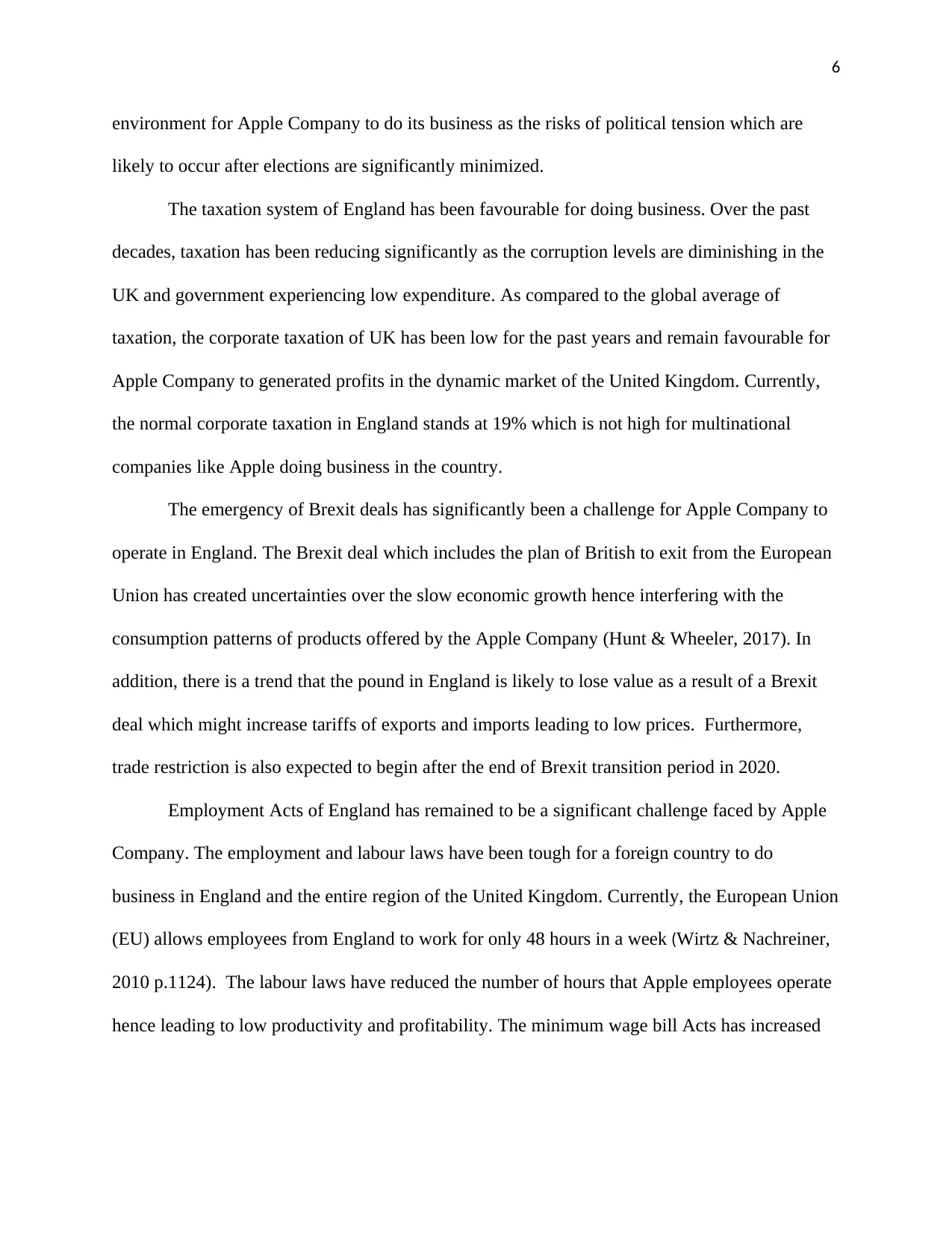
6
environment for Apple Company to do its business as the risks of political tension which are
likely to occur after elections are significantly minimized.
The taxation system of England has been favourable for doing business. Over the past
decades, taxation has been reducing significantly as the corruption levels are diminishing in the
UK and government experiencing low expenditure. As compared to the global average of
taxation, the corporate taxation of UK has been low for the past years and remain favourable for
Apple Company to generated profits in the dynamic market of the United Kingdom. Currently,
the normal corporate taxation in England stands at 19% which is not high for multinational
companies like Apple doing business in the country.
The emergency of Brexit deals has significantly been a challenge for Apple Company to
operate in England. The Brexit deal which includes the plan of British to exit from the European
Union has created uncertainties over the slow economic growth hence interfering with the
consumption patterns of products offered by the Apple Company (Hunt & Wheeler, 2017). In
addition, there is a trend that the pound in England is likely to lose value as a result of a Brexit
deal which might increase tariffs of exports and imports leading to low prices. Furthermore,
trade restriction is also expected to begin after the end of Brexit transition period in 2020.
Employment Acts of England has remained to be a significant challenge faced by Apple
Company. The employment and labour laws have been tough for a foreign country to do
business in England and the entire region of the United Kingdom. Currently, the European Union
(EU) allows employees from England to work for only 48 hours in a week (Wirtz & Nachreiner,
2010 p.1124). The labour laws have reduced the number of hours that Apple employees operate
hence leading to low productivity and profitability. The minimum wage bill Acts has increased
environment for Apple Company to do its business as the risks of political tension which are
likely to occur after elections are significantly minimized.
The taxation system of England has been favourable for doing business. Over the past
decades, taxation has been reducing significantly as the corruption levels are diminishing in the
UK and government experiencing low expenditure. As compared to the global average of
taxation, the corporate taxation of UK has been low for the past years and remain favourable for
Apple Company to generated profits in the dynamic market of the United Kingdom. Currently,
the normal corporate taxation in England stands at 19% which is not high for multinational
companies like Apple doing business in the country.
The emergency of Brexit deals has significantly been a challenge for Apple Company to
operate in England. The Brexit deal which includes the plan of British to exit from the European
Union has created uncertainties over the slow economic growth hence interfering with the
consumption patterns of products offered by the Apple Company (Hunt & Wheeler, 2017). In
addition, there is a trend that the pound in England is likely to lose value as a result of a Brexit
deal which might increase tariffs of exports and imports leading to low prices. Furthermore,
trade restriction is also expected to begin after the end of Brexit transition period in 2020.
Employment Acts of England has remained to be a significant challenge faced by Apple
Company. The employment and labour laws have been tough for a foreign country to do
business in England and the entire region of the United Kingdom. Currently, the European Union
(EU) allows employees from England to work for only 48 hours in a week (Wirtz & Nachreiner,
2010 p.1124). The labour laws have reduced the number of hours that Apple employees operate
hence leading to low productivity and profitability. The minimum wage bill Acts has increased
⊘ This is a preview!⊘
Do you want full access?
Subscribe today to unlock all pages.

Trusted by 1+ million students worldwide
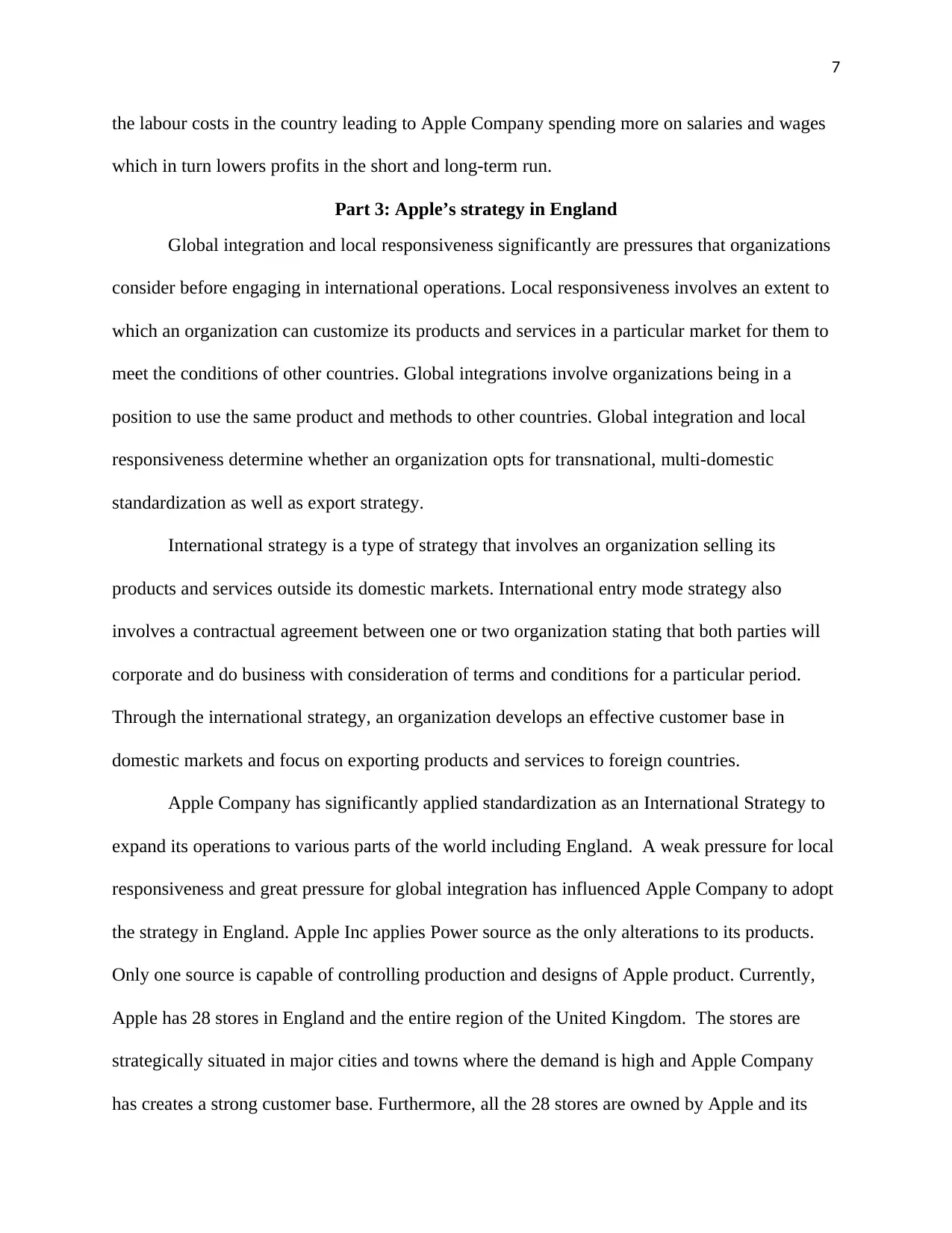
7
the labour costs in the country leading to Apple Company spending more on salaries and wages
which in turn lowers profits in the short and long-term run.
Part 3: Apple’s strategy in England
Global integration and local responsiveness significantly are pressures that organizations
consider before engaging in international operations. Local responsiveness involves an extent to
which an organization can customize its products and services in a particular market for them to
meet the conditions of other countries. Global integrations involve organizations being in a
position to use the same product and methods to other countries. Global integration and local
responsiveness determine whether an organization opts for transnational, multi-domestic
standardization as well as export strategy.
International strategy is a type of strategy that involves an organization selling its
products and services outside its domestic markets. International entry mode strategy also
involves a contractual agreement between one or two organization stating that both parties will
corporate and do business with consideration of terms and conditions for a particular period.
Through the international strategy, an organization develops an effective customer base in
domestic markets and focus on exporting products and services to foreign countries.
Apple Company has significantly applied standardization as an International Strategy to
expand its operations to various parts of the world including England. A weak pressure for local
responsiveness and great pressure for global integration has influenced Apple Company to adopt
the strategy in England. Apple Inc applies Power source as the only alterations to its products.
Only one source is capable of controlling production and designs of Apple product. Currently,
Apple has 28 stores in England and the entire region of the United Kingdom. The stores are
strategically situated in major cities and towns where the demand is high and Apple Company
has creates a strong customer base. Furthermore, all the 28 stores are owned by Apple and its
the labour costs in the country leading to Apple Company spending more on salaries and wages
which in turn lowers profits in the short and long-term run.
Part 3: Apple’s strategy in England
Global integration and local responsiveness significantly are pressures that organizations
consider before engaging in international operations. Local responsiveness involves an extent to
which an organization can customize its products and services in a particular market for them to
meet the conditions of other countries. Global integrations involve organizations being in a
position to use the same product and methods to other countries. Global integration and local
responsiveness determine whether an organization opts for transnational, multi-domestic
standardization as well as export strategy.
International strategy is a type of strategy that involves an organization selling its
products and services outside its domestic markets. International entry mode strategy also
involves a contractual agreement between one or two organization stating that both parties will
corporate and do business with consideration of terms and conditions for a particular period.
Through the international strategy, an organization develops an effective customer base in
domestic markets and focus on exporting products and services to foreign countries.
Apple Company has significantly applied standardization as an International Strategy to
expand its operations to various parts of the world including England. A weak pressure for local
responsiveness and great pressure for global integration has influenced Apple Company to adopt
the strategy in England. Apple Inc applies Power source as the only alterations to its products.
Only one source is capable of controlling production and designs of Apple product. Currently,
Apple has 28 stores in England and the entire region of the United Kingdom. The stores are
strategically situated in major cities and towns where the demand is high and Apple Company
has creates a strong customer base. Furthermore, all the 28 stores are owned by Apple and its
Paraphrase This Document
Need a fresh take? Get an instant paraphrase of this document with our AI Paraphraser
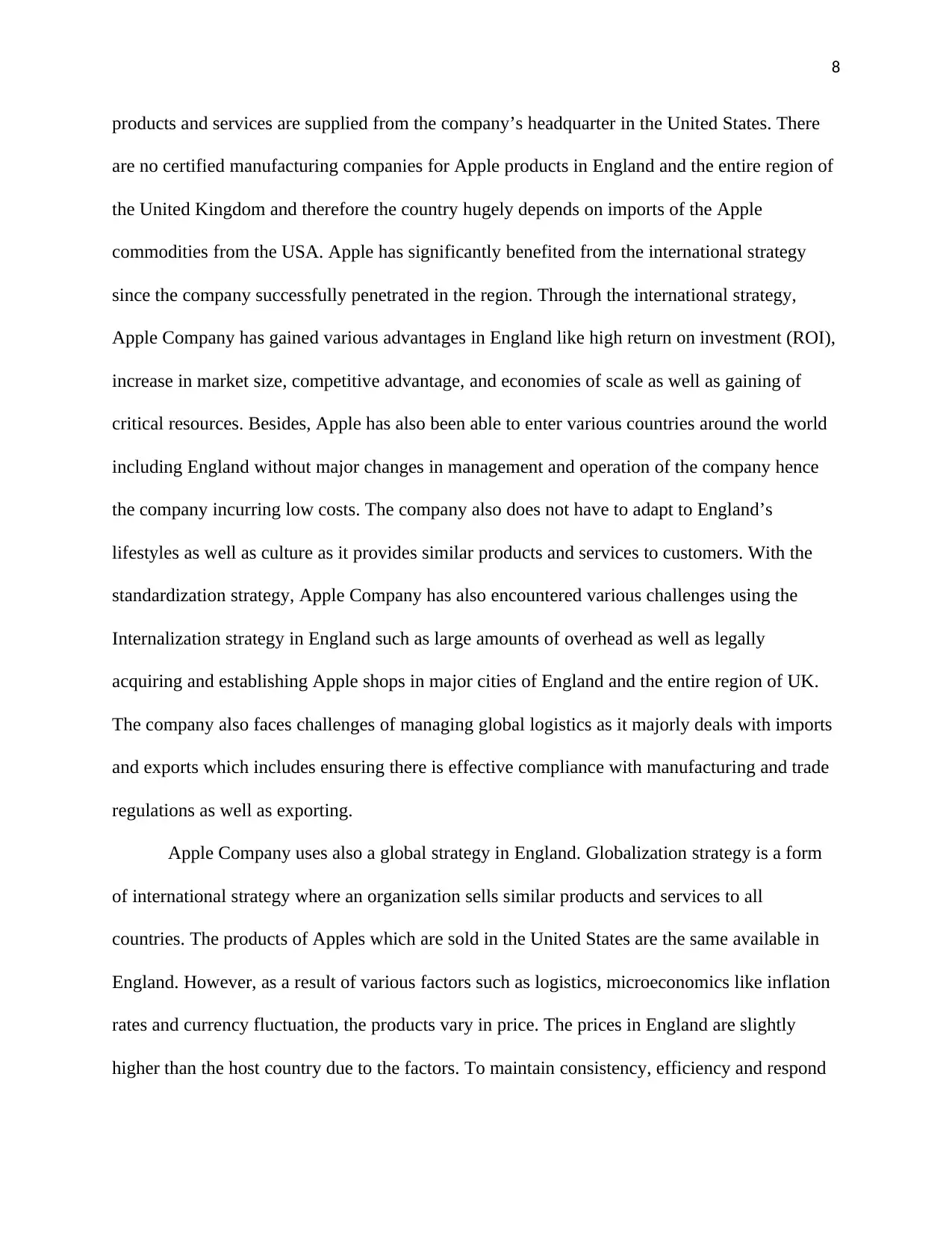
8
products and services are supplied from the company’s headquarter in the United States. There
are no certified manufacturing companies for Apple products in England and the entire region of
the United Kingdom and therefore the country hugely depends on imports of the Apple
commodities from the USA. Apple has significantly benefited from the international strategy
since the company successfully penetrated in the region. Through the international strategy,
Apple Company has gained various advantages in England like high return on investment (ROI),
increase in market size, competitive advantage, and economies of scale as well as gaining of
critical resources. Besides, Apple has also been able to enter various countries around the world
including England without major changes in management and operation of the company hence
the company incurring low costs. The company also does not have to adapt to England’s
lifestyles as well as culture as it provides similar products and services to customers. With the
standardization strategy, Apple Company has also encountered various challenges using the
Internalization strategy in England such as large amounts of overhead as well as legally
acquiring and establishing Apple shops in major cities of England and the entire region of UK.
The company also faces challenges of managing global logistics as it majorly deals with imports
and exports which includes ensuring there is effective compliance with manufacturing and trade
regulations as well as exporting.
Apple Company uses also a global strategy in England. Globalization strategy is a form
of international strategy where an organization sells similar products and services to all
countries. The products of Apples which are sold in the United States are the same available in
England. However, as a result of various factors such as logistics, microeconomics like inflation
rates and currency fluctuation, the products vary in price. The prices in England are slightly
higher than the host country due to the factors. To maintain consistency, efficiency and respond
products and services are supplied from the company’s headquarter in the United States. There
are no certified manufacturing companies for Apple products in England and the entire region of
the United Kingdom and therefore the country hugely depends on imports of the Apple
commodities from the USA. Apple has significantly benefited from the international strategy
since the company successfully penetrated in the region. Through the international strategy,
Apple Company has gained various advantages in England like high return on investment (ROI),
increase in market size, competitive advantage, and economies of scale as well as gaining of
critical resources. Besides, Apple has also been able to enter various countries around the world
including England without major changes in management and operation of the company hence
the company incurring low costs. The company also does not have to adapt to England’s
lifestyles as well as culture as it provides similar products and services to customers. With the
standardization strategy, Apple Company has also encountered various challenges using the
Internalization strategy in England such as large amounts of overhead as well as legally
acquiring and establishing Apple shops in major cities of England and the entire region of UK.
The company also faces challenges of managing global logistics as it majorly deals with imports
and exports which includes ensuring there is effective compliance with manufacturing and trade
regulations as well as exporting.
Apple Company uses also a global strategy in England. Globalization strategy is a form
of international strategy where an organization sells similar products and services to all
countries. The products of Apples which are sold in the United States are the same available in
England. However, as a result of various factors such as logistics, microeconomics like inflation
rates and currency fluctuation, the products vary in price. The prices in England are slightly
higher than the host country due to the factors. To maintain consistency, efficiency and respond
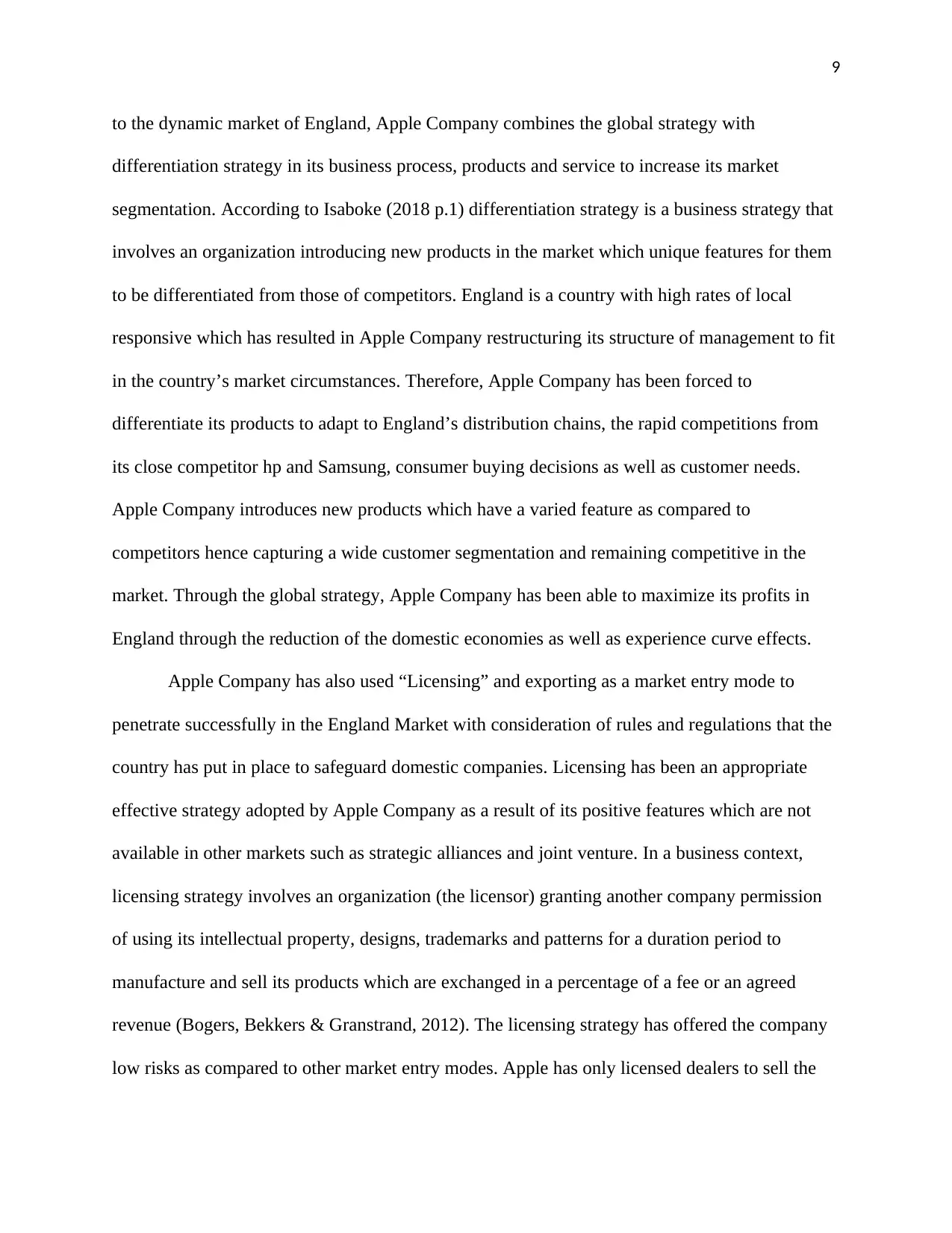
9
to the dynamic market of England, Apple Company combines the global strategy with
differentiation strategy in its business process, products and service to increase its market
segmentation. According to Isaboke (2018 p.1) differentiation strategy is a business strategy that
involves an organization introducing new products in the market which unique features for them
to be differentiated from those of competitors. England is a country with high rates of local
responsive which has resulted in Apple Company restructuring its structure of management to fit
in the country’s market circumstances. Therefore, Apple Company has been forced to
differentiate its products to adapt to England’s distribution chains, the rapid competitions from
its close competitor hp and Samsung, consumer buying decisions as well as customer needs.
Apple Company introduces new products which have a varied feature as compared to
competitors hence capturing a wide customer segmentation and remaining competitive in the
market. Through the global strategy, Apple Company has been able to maximize its profits in
England through the reduction of the domestic economies as well as experience curve effects.
Apple Company has also used “Licensing” and exporting as a market entry mode to
penetrate successfully in the England Market with consideration of rules and regulations that the
country has put in place to safeguard domestic companies. Licensing has been an appropriate
effective strategy adopted by Apple Company as a result of its positive features which are not
available in other markets such as strategic alliances and joint venture. In a business context,
licensing strategy involves an organization (the licensor) granting another company permission
of using its intellectual property, designs, trademarks and patterns for a duration period to
manufacture and sell its products which are exchanged in a percentage of a fee or an agreed
revenue (Bogers, Bekkers & Granstrand, 2012). The licensing strategy has offered the company
low risks as compared to other market entry modes. Apple has only licensed dealers to sell the
to the dynamic market of England, Apple Company combines the global strategy with
differentiation strategy in its business process, products and service to increase its market
segmentation. According to Isaboke (2018 p.1) differentiation strategy is a business strategy that
involves an organization introducing new products in the market which unique features for them
to be differentiated from those of competitors. England is a country with high rates of local
responsive which has resulted in Apple Company restructuring its structure of management to fit
in the country’s market circumstances. Therefore, Apple Company has been forced to
differentiate its products to adapt to England’s distribution chains, the rapid competitions from
its close competitor hp and Samsung, consumer buying decisions as well as customer needs.
Apple Company introduces new products which have a varied feature as compared to
competitors hence capturing a wide customer segmentation and remaining competitive in the
market. Through the global strategy, Apple Company has been able to maximize its profits in
England through the reduction of the domestic economies as well as experience curve effects.
Apple Company has also used “Licensing” and exporting as a market entry mode to
penetrate successfully in the England Market with consideration of rules and regulations that the
country has put in place to safeguard domestic companies. Licensing has been an appropriate
effective strategy adopted by Apple Company as a result of its positive features which are not
available in other markets such as strategic alliances and joint venture. In a business context,
licensing strategy involves an organization (the licensor) granting another company permission
of using its intellectual property, designs, trademarks and patterns for a duration period to
manufacture and sell its products which are exchanged in a percentage of a fee or an agreed
revenue (Bogers, Bekkers & Granstrand, 2012). The licensing strategy has offered the company
low risks as compared to other market entry modes. Apple has only licensed dealers to sell the
⊘ This is a preview!⊘
Do you want full access?
Subscribe today to unlock all pages.

Trusted by 1+ million students worldwide
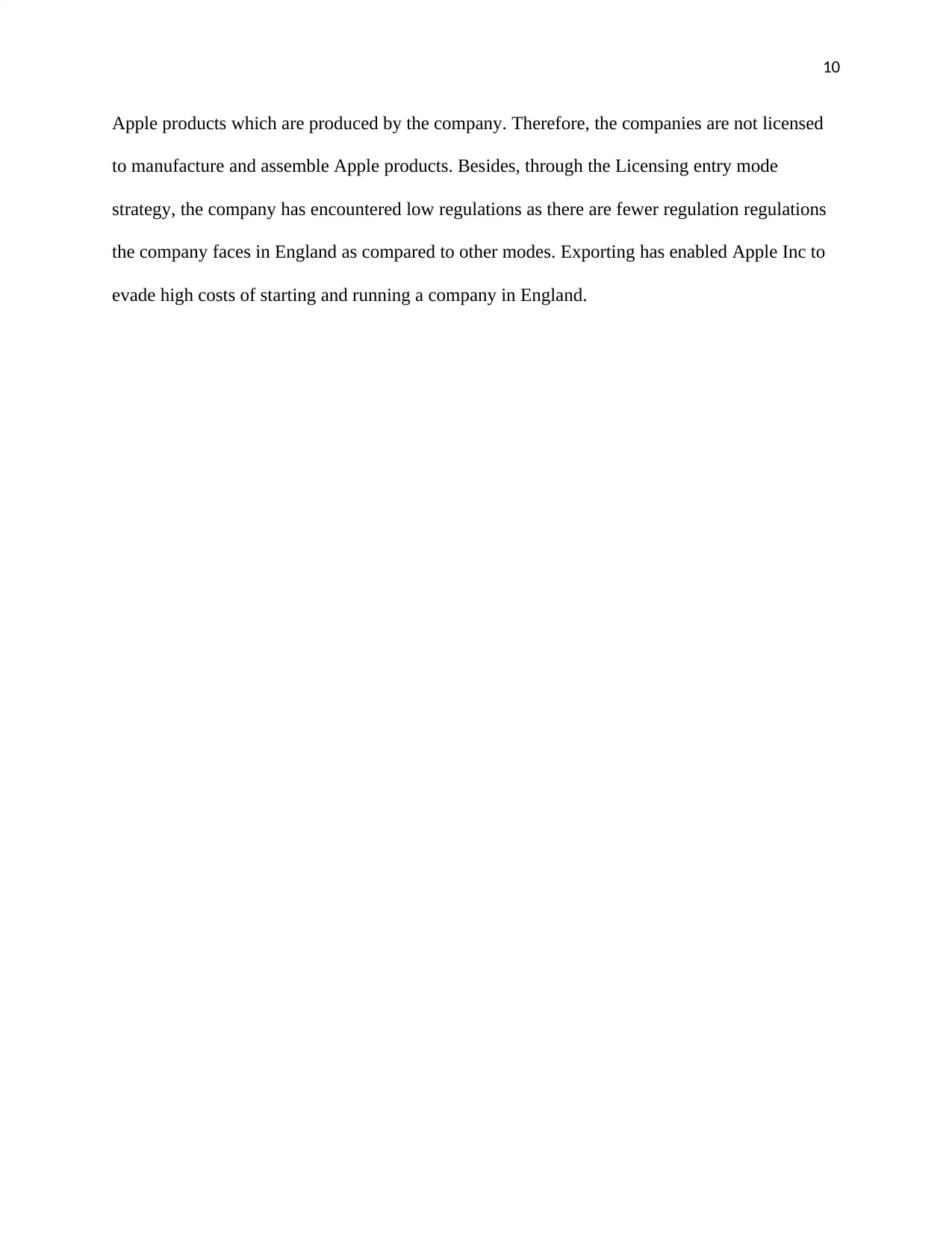
10
Apple products which are produced by the company. Therefore, the companies are not licensed
to manufacture and assemble Apple products. Besides, through the Licensing entry mode
strategy, the company has encountered low regulations as there are fewer regulation regulations
the company faces in England as compared to other modes. Exporting has enabled Apple Inc to
evade high costs of starting and running a company in England.
Apple products which are produced by the company. Therefore, the companies are not licensed
to manufacture and assemble Apple products. Besides, through the Licensing entry mode
strategy, the company has encountered low regulations as there are fewer regulation regulations
the company faces in England as compared to other modes. Exporting has enabled Apple Inc to
evade high costs of starting and running a company in England.
Paraphrase This Document
Need a fresh take? Get an instant paraphrase of this document with our AI Paraphraser
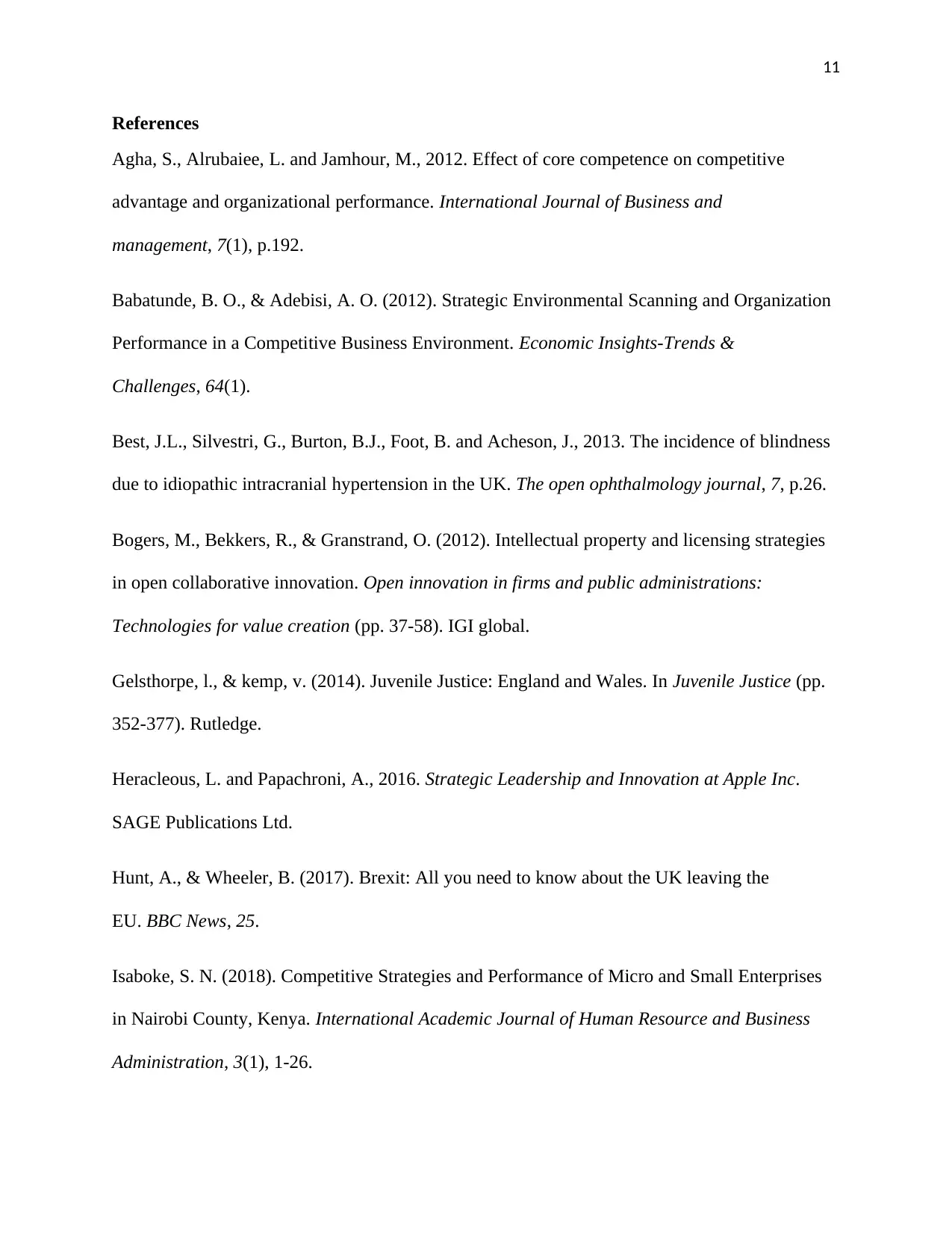
11
References
Agha, S., Alrubaiee, L. and Jamhour, M., 2012. Effect of core competence on competitive
advantage and organizational performance. International Journal of Business and
management, 7(1), p.192.
Babatunde, B. O., & Adebisi, A. O. (2012). Strategic Environmental Scanning and Organization
Performance in a Competitive Business Environment. Economic Insights-Trends &
Challenges, 64(1).
Best, J.L., Silvestri, G., Burton, B.J., Foot, B. and Acheson, J., 2013. The incidence of blindness
due to idiopathic intracranial hypertension in the UK. The open ophthalmology journal, 7, p.26.
Bogers, M., Bekkers, R., & Granstrand, O. (2012). Intellectual property and licensing strategies
in open collaborative innovation. Open innovation in firms and public administrations:
Technologies for value creation (pp. 37-58). IGI global.
Gelsthorpe, l., & kemp, v. (2014). Juvenile Justice: England and Wales. In Juvenile Justice (pp.
352-377). Rutledge.
Heracleous, L. and Papachroni, A., 2016. Strategic Leadership and Innovation at Apple Inc.
SAGE Publications Ltd.
Hunt, A., & Wheeler, B. (2017). Brexit: All you need to know about the UK leaving the
EU. BBC News, 25.
Isaboke, S. N. (2018). Competitive Strategies and Performance of Micro and Small Enterprises
in Nairobi County, Kenya. International Academic Journal of Human Resource and Business
Administration, 3(1), 1-26.
References
Agha, S., Alrubaiee, L. and Jamhour, M., 2012. Effect of core competence on competitive
advantage and organizational performance. International Journal of Business and
management, 7(1), p.192.
Babatunde, B. O., & Adebisi, A. O. (2012). Strategic Environmental Scanning and Organization
Performance in a Competitive Business Environment. Economic Insights-Trends &
Challenges, 64(1).
Best, J.L., Silvestri, G., Burton, B.J., Foot, B. and Acheson, J., 2013. The incidence of blindness
due to idiopathic intracranial hypertension in the UK. The open ophthalmology journal, 7, p.26.
Bogers, M., Bekkers, R., & Granstrand, O. (2012). Intellectual property and licensing strategies
in open collaborative innovation. Open innovation in firms and public administrations:
Technologies for value creation (pp. 37-58). IGI global.
Gelsthorpe, l., & kemp, v. (2014). Juvenile Justice: England and Wales. In Juvenile Justice (pp.
352-377). Rutledge.
Heracleous, L. and Papachroni, A., 2016. Strategic Leadership and Innovation at Apple Inc.
SAGE Publications Ltd.
Hunt, A., & Wheeler, B. (2017). Brexit: All you need to know about the UK leaving the
EU. BBC News, 25.
Isaboke, S. N. (2018). Competitive Strategies and Performance of Micro and Small Enterprises
in Nairobi County, Kenya. International Academic Journal of Human Resource and Business
Administration, 3(1), 1-26.
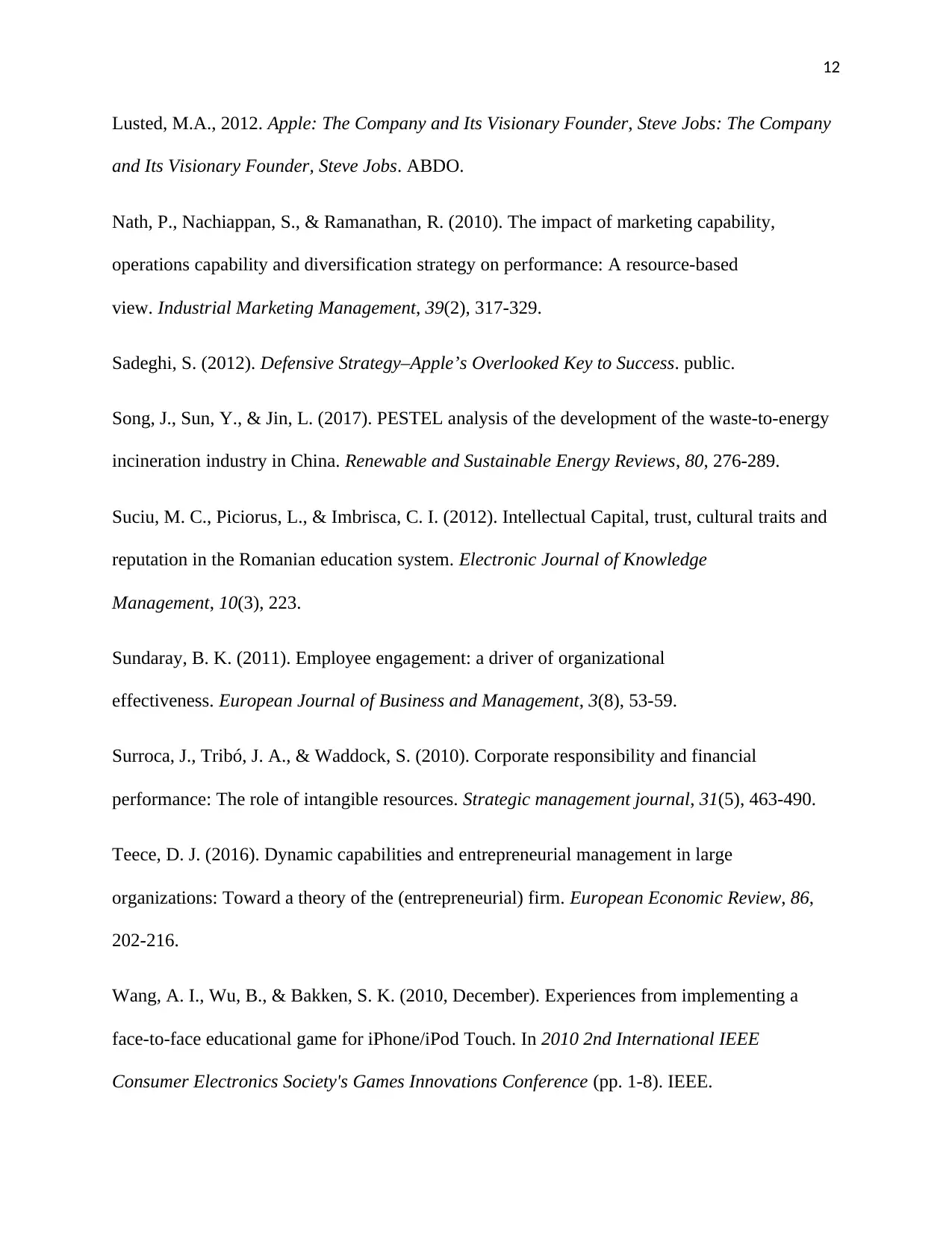
12
Lusted, M.A., 2012. Apple: The Company and Its Visionary Founder, Steve Jobs: The Company
and Its Visionary Founder, Steve Jobs. ABDO.
Nath, P., Nachiappan, S., & Ramanathan, R. (2010). The impact of marketing capability,
operations capability and diversification strategy on performance: A resource-based
view. Industrial Marketing Management, 39(2), 317-329.
Sadeghi, S. (2012). Defensive Strategy–Apple’s Overlooked Key to Success. public.
Song, J., Sun, Y., & Jin, L. (2017). PESTEL analysis of the development of the waste-to-energy
incineration industry in China. Renewable and Sustainable Energy Reviews, 80, 276-289.
Suciu, M. C., Piciorus, L., & Imbrisca, C. I. (2012). Intellectual Capital, trust, cultural traits and
reputation in the Romanian education system. Electronic Journal of Knowledge
Management, 10(3), 223.
Sundaray, B. K. (2011). Employee engagement: a driver of organizational
effectiveness. European Journal of Business and Management, 3(8), 53-59.
Surroca, J., Tribó, J. A., & Waddock, S. (2010). Corporate responsibility and financial
performance: The role of intangible resources. Strategic management journal, 31(5), 463-490.
Teece, D. J. (2016). Dynamic capabilities and entrepreneurial management in large
organizations: Toward a theory of the (entrepreneurial) firm. European Economic Review, 86,
202-216.
Wang, A. I., Wu, B., & Bakken, S. K. (2010, December). Experiences from implementing a
face-to-face educational game for iPhone/iPod Touch. In 2010 2nd International IEEE
Consumer Electronics Society's Games Innovations Conference (pp. 1-8). IEEE.
Lusted, M.A., 2012. Apple: The Company and Its Visionary Founder, Steve Jobs: The Company
and Its Visionary Founder, Steve Jobs. ABDO.
Nath, P., Nachiappan, S., & Ramanathan, R. (2010). The impact of marketing capability,
operations capability and diversification strategy on performance: A resource-based
view. Industrial Marketing Management, 39(2), 317-329.
Sadeghi, S. (2012). Defensive Strategy–Apple’s Overlooked Key to Success. public.
Song, J., Sun, Y., & Jin, L. (2017). PESTEL analysis of the development of the waste-to-energy
incineration industry in China. Renewable and Sustainable Energy Reviews, 80, 276-289.
Suciu, M. C., Piciorus, L., & Imbrisca, C. I. (2012). Intellectual Capital, trust, cultural traits and
reputation in the Romanian education system. Electronic Journal of Knowledge
Management, 10(3), 223.
Sundaray, B. K. (2011). Employee engagement: a driver of organizational
effectiveness. European Journal of Business and Management, 3(8), 53-59.
Surroca, J., Tribó, J. A., & Waddock, S. (2010). Corporate responsibility and financial
performance: The role of intangible resources. Strategic management journal, 31(5), 463-490.
Teece, D. J. (2016). Dynamic capabilities and entrepreneurial management in large
organizations: Toward a theory of the (entrepreneurial) firm. European Economic Review, 86,
202-216.
Wang, A. I., Wu, B., & Bakken, S. K. (2010, December). Experiences from implementing a
face-to-face educational game for iPhone/iPod Touch. In 2010 2nd International IEEE
Consumer Electronics Society's Games Innovations Conference (pp. 1-8). IEEE.
⊘ This is a preview!⊘
Do you want full access?
Subscribe today to unlock all pages.

Trusted by 1+ million students worldwide
1 out of 13
Related Documents
Your All-in-One AI-Powered Toolkit for Academic Success.
+13062052269
info@desklib.com
Available 24*7 on WhatsApp / Email
![[object Object]](/_next/static/media/star-bottom.7253800d.svg)
Unlock your academic potential
Copyright © 2020–2025 A2Z Services. All Rights Reserved. Developed and managed by ZUCOL.





